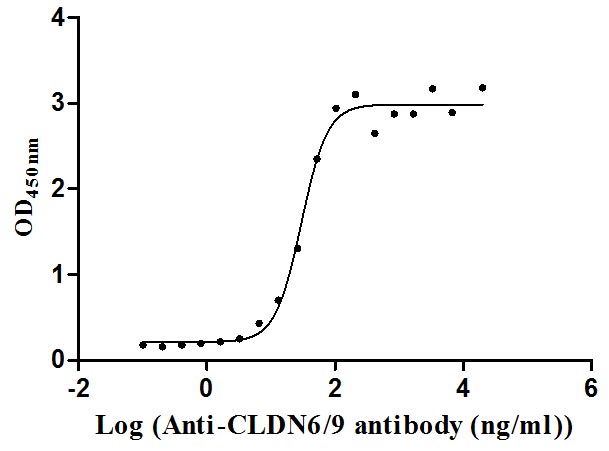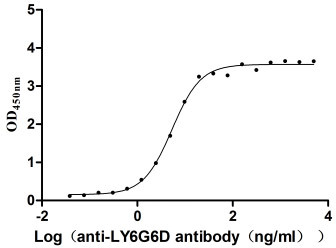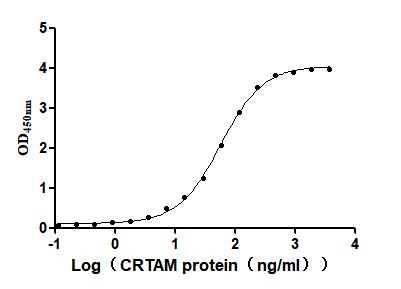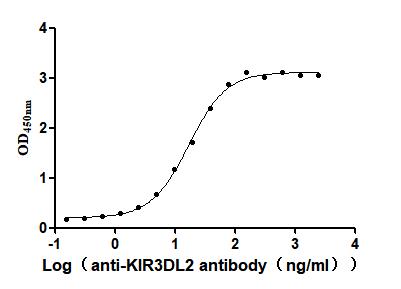Recombinant Human Dual specificity tyrosine-phosphorylation-regulated kinase 3 (DYRK3)
-
中文名稱(chēng):人DYRK3重組蛋白
-
貨號(hào):CSB-YP007312HU
-
說(shuō)明書(shū):
-
規(guī)格:
-
來(lái)源:Yeast
-
其他:
-
中文名稱(chēng):人DYRK3重組蛋白
-
貨號(hào):CSB-EP007312HU
-
說(shuō)明書(shū):
-
規(guī)格:
-
來(lái)源:E.coli
-
其他:
-
中文名稱(chēng):人DYRK3重組蛋白
-
貨號(hào):CSB-EP007312HU-B
-
說(shuō)明書(shū):
-
規(guī)格:
-
來(lái)源:E.coli
-
共軛:Avi-tag Biotinylated
E. coli biotin ligase (BirA) is highly specific in covalently attaching biotin to the 15 amino acid AviTag peptide. This recombinant protein was biotinylated in vivo by AviTag-BirA technology, which method is BriA catalyzes amide linkage between the biotin and the specific lysine of the AviTag.
-
其他:
-
中文名稱(chēng):人DYRK3重組蛋白
-
貨號(hào):CSB-BP007312HU
-
說(shuō)明書(shū):
-
規(guī)格:
-
來(lái)源:Baculovirus
-
其他:
產(chǎn)品詳情
-
純度:>85% (SDS-PAGE)
-
基因名:DYRK3
-
Uniprot No.:
-
別名:Dual specificity tyrosine (Y) phosphorylation regulated kinase 3; Dual specificity tyrosine phosphorylation-regulated kinase 3; Dual specificity tyrosine-phosphorylation-regulated kinase 3; Dyrk3; DYRK3_HUMAN; DYRK5; hYAK3 2; Protein kinase Dyrk3; RED; REDK; Regulatory erythroid kinase
-
種屬:Homo sapiens (Human)
-
蛋白長(zhǎng)度:Full length protein
-
表達(dá)區(qū)域:1-588
-
氨基酸序列MGGTARGPGR KDAGPPGAGL PPQQRRLGDG VYDTFMMIDE TKCPPCSNVL CNPSEPPPPR RLNMTTEQFT GDHTQHFLDG GEMKVEQLFQ EFGNRKSNTI QSDGISDSEK CSPTVSQGKS SDCLNTVKSN SSSKAPKVVP LTPEQALKQY KHHLTAYEKL EIINYPEIYF VGPNAKKRHG VIGGPNNGGY DDADGAYIHV PRDHLAYRYE VLKIIGKGSF GQVARVYDHK LRQYVALKMV RNEKRFHRQA AEEIRILEHL KKQDKTGSMN VIHMLESFTF RNHVCMAFEL LSIDLYELIK KNKFQGFSVQ LVRKFAQSIL QSLDALHKNK IIHCDLKPEN ILLKHHGRSS TKVIDFGSSC FEYQKLYTYI QSRFYRAPEI ILGSRYSTPI DIWSFGCILA ELLTGQPLFP GEDEGDQLAC MMELLGMPPP KLLEQSKRAK YFINSKGIPR YCSVTTQADG RVVLVGGRSR RGKKRGPPGS KDWGTALKGC DDYLFIEFLK RCLHWDPSAR LTPAQALRHP WISKSVPRPL TTIDKVSGKR VVNPASAFQG LGSKLPPVVG IANKLKANLM SETNGSIPLC SVLPKLIS
-
蛋白標(biāo)簽:Tag?type?will?be?determined?during?the?manufacturing?process.
The tag type will be determined during production process. If you have specified tag type, please tell us and we will develop the specified tag preferentially. -
產(chǎn)品提供形式:Lyophilized powder Warning: in_array() expects parameter 2 to be array, null given in /www/web/cusabio_cn/public_html/caches/caches_template/default/content/show_product_protein.php on line 662
Note: We will preferentially ship the format that we have in stock, however, if you have any special requirement for the format, please remark your requirement when placing the order, we will prepare according to your demand. -
復(fù)溶:We recommend that this vial be briefly centrifuged prior to opening to bring the contents to the bottom. Please reconstitute protein in deionized sterile water to a concentration of 0.1-1.0 mg/mL.We recommend to add 5-50% of glycerol (final concentration) and aliquot for long-term storage at -20℃/-80℃. Our default final concentration of glycerol is 50%. Customers could use it as reference.
-
儲(chǔ)存條件:Store at -20°C/-80°C upon receipt, aliquoting is necessary for mutiple use. Avoid repeated freeze-thaw cycles.
-
保質(zhì)期:The shelf life is related to many factors, storage state, buffer ingredients, storage temperature and the stability of the protein itself.
Generally, the shelf life of liquid form is 6 months at -20°C/-80°C. The shelf life of lyophilized form is 12 months at -20°C/-80°C. -
貨期:Delivery time may differ from different purchasing way or location, please kindly consult your local distributors for specific delivery time.Note: All of our proteins are default shipped with normal blue ice packs, if you request to ship with dry ice, please communicate with us in advance and extra fees will be charged.
-
注意事項(xiàng):Repeated freezing and thawing is not recommended. Store working aliquots at 4°C for up to one week.
-
Datasheet :Please contact us to get it.
相關(guān)產(chǎn)品
靶點(diǎn)詳情
-
功能:Dual-specificity protein kinase that promotes disassembly of several types of membraneless organelles during mitosis, such as stress granules, nuclear speckles and pericentriolar material. Dual-specificity tyrosine-regulated kinases (DYRKs) autophosphorylate a critical tyrosine residue in their activation loop and phosphorylate their substrate on serine and threonine residues. Acts as a central dissolvase of membraneless organelles during the G2-to-M transition, after the nuclear-envelope breakdown: acts by mediating phosphorylation of multiple serine and threonine residues in unstructured domains of proteins, such as SRRM1 and PCM1. Does not mediate disassembly of all membraneless organelles: disassembly of P-body and nucleolus is not regulated by DYRK3. Dissolution of membraneless organelles at the onset of mitosis is also required to release mitotic regulators, such as ZNF207, from liquid-unmixed organelles where they are sequestered and keep them dissolved during mitosis. Regulates mTORC1 by mediating the dissolution of stress granules: during stressful conditions, DYRK3 partitions from the cytosol to the stress granule, together with mTORC1 components, which prevents mTORC1 signaling. When stress signals are gone, the kinase activity of DYRK3 is required for the dissolution of stress granule and mTORC1 relocation to the cytosol: acts by mediating the phosphorylation of the mTORC1 inhibitor AKT1S1, allowing full reactivation of mTORC1 signaling. Also acts as a negative regulator of EPO-dependent erythropoiesis: may place an upper limit on red cell production during stress erythropoiesis. Inhibits cell death due to cytokine withdrawal in hematopoietic progenitor cells. Promotes cell survival upon genotoxic stress through phosphorylation of SIRT1: this in turn inhibits p53/TP53 activity and apoptosis.
-
基因功能參考文獻(xiàn):
- Study identified the dual specificity tyrosine-phosphorylation-regulated kinase 3 (DYRK3) as a protein with the ability to condense P-granule-like speckles in the cytosol and to prevent stress granule dissolution via its N-terminal domain when it is in a kinase-inactive form. PMID: 23415227
- the lipid raft-dependent endocytosis process mediates C. neoformans internalization into HBMEC and the CD44 protein of the hosts, cytoskeleton, and intracellular kinase-DYRK3 are involved in this process PMID: 21693704
- DYRK1A and DYRK3 promote cell survival through phosphorylation and activation of SIRT1. PMID: 20167603
- DYRK3 has roles in kinase activation, binding to CREB, and hematopoietic progenitor cell survival PMID: 12356771
- DYRK3, expression is strong in erythroid cells and testis, but is also detected in adult kidney and liver PMID: 15607427
- DYRK3 dual-specificity kinase attenuates erythropoiesis during anemia PMID: 18854306
顯示更多
收起更多
-
亞細(xì)胞定位:Nucleus. Cytoplasm. Nucleus speckle. Cytoplasmic granule. Cytoplasm, cytoskeleton, microtubule organizing center, centrosome.
-
蛋白家族:Protein kinase superfamily, CMGC Ser/Thr protein kinase family, MNB/DYRK subfamily
-
組織特異性:Isoform 1: Highly expressed in testis and in hematopoietic tissue such as fetal liver, and bone marrow. Isoform 1: Predominant form in fetal liver and bone marrow. Isoform 1: Present at low levels in heart, pancreas, lymph node and thymus. Isoform 2: High
-
數(shù)據(jù)庫(kù)鏈接:
Most popular with customers
-
Recombinant Dog Angiopoietin-2 (ANGPT2) (Active)
Express system: Mammalian cell
Species: Canis lupus familiaris (Dog) (Canis familiaris)
-
Recombinant Human Claudin-9 (CLDN9)-VLPs (Active)
Express system: Mammalian cell
Species: Homo sapiens (Human)
-
Recombinant Human Dickkopf-related protein 1 (DKK1) (Active)
Express system: Mammalian cell
Species: Homo sapiens (Human)
-
Recombinant Macaca fascicularis lymphocyte antigen 6 family member G6D (LY6G6D) (Active)
Express system: Yeast
Species: Macaca fascicularis (Crab-eating macaque) (Cynomolgus monkey)
-
Recombinant Macaca fascicularis Membrane spanning 4-domains A1 (MS4A1)-VLPs (Active)
Express system: Mammalian cell
Species: Macaca fascicularis (Crab-eating macaque) (Cynomolgus monkey)
-
Recombinant Mouse CUB domain-containing protein 1 (Cdcp1), partial (Active)
Express system: Mammalian cell
Species: Mus musculus (Mouse)
-
Recombinant Mouse Cytotoxic and regulatory T-cell molecule (Crtam), partial (Active)
Express system: Mammalian cell
Species: Mus musculus (Mouse)
-
Recombinant Human Killer cell immunoglobulin-like receptor 3DL2 (KIR3DL2), partial (Active)
Express system: Mammalian cell
Species: Homo sapiens (Human)




-AC1.jpg)














